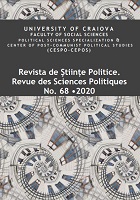Communication and NGOs in Romania – A case study
Communication and NGOs in Romania – A case study
Author(s): Valentina MarinescuSubject(s): Media studies, Civil Society, Communication studies
Published by: Editura Universitaria Craiova
Keywords: communication; NGO; media; qualitative methods; volunteers;
Summary/Abstract: Romania is among the states with a low rate of volunteering. According to existing data, one could notice that only 10-19% of the population was involved in voluntary activities in the last years. The difference between Romania, on the one hand, and Western Europe, on the other is the result of a historical evolution. In Western Europe, in average, more than 40% of the total number of the population is involved in volunteering, this being the case for Austria, the Netherlands, Sweden and the United Kingdom. The present paper intends to identify the way in which the Romanian NGOs used different media to promote their activities and what are the practical results for those organizations. As a general research assumption, we had the following statement: The communication channels used by NGOs could influence the way they accomplish their purpose and mission. As secondary assumptions, we have: (1) The story conveyed is more important than the presence on different communication platforms and (2) In Non-Governmental Organizations the efficiency of external communication is directly proportional with the efficiency of internal communication. The main research method used was the interview which was applied to a sample of ten respondents working in the non-governmental sector in Romania, all from the same NGO. The results of the study indicate that Romanian NGOs use new types of media (social media, websites, online newspapers, blogs) to promote themselves. Field events organized by Romanian NGOs are mostly interactive, gathering people and volunteers in parks, cinemas and theaters to enter into different activities with their target audiences composed mainly of young people aged 14-18 which came from disadvantaged social categories). The results have confirmed both the main hypothesis and both secondary hypotheses. The members of Romanian NGOs stated that their presence online as representatives of the voluntary activities had helped them in fulfilling their missions.
Journal: Revista de Științe Politice. Revue des Sciences Politiques
- Issue Year: 2020
- Issue No: 68
- Page Range: 12-21
- Page Count: 10
- Language: English

